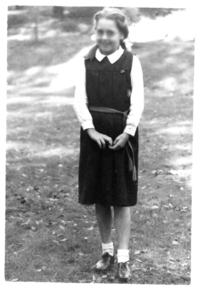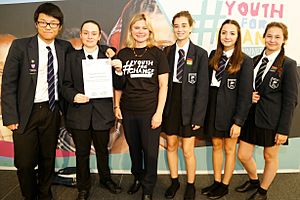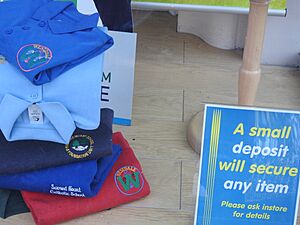School uniforms in England facts for kids
School uniforms in England are worn by students in most primary and secondary schools. More than 90% of schools in England use uniforms. Parents usually need to buy these uniforms. In 2015, the average cost for one child's uniform was about £212.88.
The Department for Education, which is part of the government, encourages all schools in England to have a uniform.
Contents
History of School Uniforms
The idea of school uniforms is very old! The first time a uniform was mentioned in writing for boys was in 1222. The Archbishop of Canterbury said that students should wear a robe-like outfit called the "cappa clausa."
In the early 1500s, children at charity schools were given old clothes. Then, in 1552, a charity called Christ's Hospital made a uniform for its students. It was meant to show that the children were not rich. The uniform looked like a church robe and was first reddish-brown, but it changed to blue after one year. Their yellow underskirts were supposed to stop bugs, but these changed to white in 1865. Boys didn't wear Breeches (short trousers) until 1706.
Other children were not as lucky. Village children might learn to read and write at their local church school. In new factory towns, many children worked full-time and also went to Sunday Schools. The Stockport Sunday School was very big. Its teachers were mostly volunteers, and students went there by choice. There was no uniform, so children wore their everyday clothes.
Most schools slowly started using uniforms. It was rare before the 1800s. Uniforms became more common because uniforms appeared in other jobs, men's clothes became simpler, and sports clothes started to appear.
The 1800s: Uniforms Become More Common
At the start of the 1800s, a law called the Health and Morals of Apprentices Act 1802 tried to make sure children learned to read, write, and about religion. But this law was not properly checked. Boys still wore their own clothes to school.
Around 1820, fancy private schools, called public schools, made their dress codes official. They chose clothes that rich children were already wearing. For example, Eton College introduced the Eton suit for younger boys. It had a short, dark jacket, grey trousers, a big white collar, and a top hat. Other public schools had their own styles. Local grammar schools also started to use simple uniforms. These often included a short jacket and trousers, a white collar, a bow tie or tie, and a round cap.
In 1870, a new law, the Elementary Education Act 1870, made basic education available for all children in England and Wales. Headteachers at grammar schools made their students wear uniforms to look different from students at the new school board schools. Younger boys at these new schools often wore knickerbockers (baggy trousers that gathered below the knee), black wool socks, leather boots, white shirts with stiff collars, and a lounge or Norfolk jacket. The Norfolk jacket was a sporty jacket with a belt and pleats. It became popular for school and weekend wear in the late 1800s.
Girls generally did not wear uniforms throughout the 1800s. But as schools started teaching girls team sports and exercise, special clothes for these activities appeared. Tight tops and long skirts were not good for active sports. So, stretchy jerseys or loose blouses and knee-length skirts or ‘bloomers’ (loose trousers gathered at the knee) with coloured sashes were worn. By the end of the century, these practical sports clothes became the general school uniform for girls.
The 1900s: Modern Uniforms Appear
In the early 1900s, private and grammar schools kept their uniforms of knickerbockers, Norfolk or lounge jackets, white shirts with collars, and ties. Shorts were worn for sports.
After the First World War, knickerbockers became less common for younger boys. Shorts became popular instead. Black socks and boots were replaced by regular socks and shoes. Basic elementary schools did not have a formal uniform. Younger boys still wore comfortable knitted sweaters and flannel shorts. Older boys might wear grey flannel shorts, a shirt, tie, blazer, and cap. Older boys moved from shorts to long flannel trousers. Most schools had a rule about age or height for when boys could start wearing 'longs'. Schools also started using special coloured stripes for blazers, sweaters, ties, and caps. They also had their own unique badges for blazers and caps.
The school uniform for boys in the 1920s stayed much the same until the second half of the 1900s. This was after the Education Act 1944 made secondary education free for everyone. Also, the school leaving age was raised to 15.
Younger elementary school girls (under 14) wore dresses that followed fashion. The loose, calf-length smock-frocks of the late 1800s and early 1900s, often worn with a white or coloured pinafore over them, became shorter shift-style dresses in the 1920s. By the First World War, older schoolgirls often wore a plain, tailored calf-length skirt and sometimes a masculine-style shirt and tie. Many middle-class families sent their daughters to boarding schools. Girls in the early 1900s felt more confident.
The gymslip was first used for gymnastics and sports. It became a main part of girls' school uniforms by the 1920s, worn with a blouse and tie. In some schools, this style continued into the 1960s. Girls also wore special knitted cardigans or sweaters, blazers with felt hats, or straw boaters with bands in the school colours. Both private and local grammar schools insisted on formal uniforms with exact rules. Kidbrooke School, a new comprehensive school that opened in 1954, started with an air force blue uniform and coloured berets that showed which house the girls belonged to.
By the 1960s, people started to have two different discussions about school uniforms. Parents at schools with very strict uniform rules wanted the rules to be relaxed. They wanted uniforms to be more comfortable, like sweatshirts and polo shirts with simple grey trousers.
At the same time, parents at schools with more relaxed rules wanted the head teacher and governors to bring in strict formal uniforms. They believed this would make their children look like grammar school children from the 1950s. They thought it would also improve discipline and school standards.
School Uniform Shops
Schools used to give parents a list of items needed, including many special designs. They would say which department stores sold these items. From the 1920s to the 1950s, families would travel to big cities like London or Manchester just to buy uniforms. This was a very good business for the stores. Whole floors were set aside for boys' and girls' school uniforms. Stores hoped families would then shop in other parts of the store too.
Two visits were often needed: one for measuring and one for fitting. This was expensive for families. The lists from private schools were long, and the items could not be bought anywhere else. Famous shops included John Lewis, Selfridges, Harrods, Lewis's of Liverpool, and Kendals of Deansgate. There were also special uniform shops like Plums and Billings and Edmonds. All items had to be marked with Cash's name tapes. Grammar schools often followed the lead of private schools.
Since the late 1950s, fewer uniform items are only available from one shop. There might still be expensive blazers, but they can be worn with trousers from shops like Marks and Spencers. The old wool blazers have sometimes been replaced by polyester ones.
Why School Uniforms Are Worn
Parents often say that wearing a uniform helps all children feel like they belong at school. A company that makes school uniforms, Trutex, did some research in 2017. This research suggested that school uniforms helped stop bullying.
However, there is no clear research that shows uniforms make students get better grades. School uniforms can also be seen as a way to control how students behave.
Some schools have decided not to have a uniform. King Edward VI Community College in Totnes, Devon, stopped using uniforms in 2004. The head teacher said in 2011 that they spent too much time dealing with students who weren't following uniform rules. They wanted to focus on teaching and learning instead. However, uniforms were brought back in 2012 after parents asked for them.
In 2019, the head teacher of Marshland High School wrote to parents about changing the uniform. He explained that uniforms:
- Help make the school's values and rules stronger.
- Make students feel more like they belong and proud of their school.
- Make things fairer and reduce differences between students.
- Reduce the need to tell students off for wearing the wrong clothes.
- Help improve relationships between students and teachers, so everyone can focus on learning.
The head teacher first asked parents for their opinions. The new uniform was introduced for younger students first. The school even bought one uniform set for each child. They also offered to pay 75% of the cost for poorer families. This helped with worries about how much uniforms cost.
The Cost of School Uniforms
For some families, buying uniforms is very hard. Some parents have even turned off their heating or gone into debt to afford them.
A study in 2007 found that secondary schools (for older children) were more likely to require specific uniform items than primary schools (for younger children).

In primary schools, some uniform items are optional. The items that more than a third of primary schools require are:
- Sweatshirts or fleeces (53%)
- Trousers (44%)
- Shirts or blouses (39%)
- Skirts or kilts (36%)
Secondary schools usually require more uniform items than primary schools. Common required items are:
- Shirts or blouses (80% for boys, 82% for girls)
- Trousers (80% for boys, 39% for girls)
- Skirts or kilts (43% for girls)
- Ties (63% for all)
- Specific types of shoes (37% for boys, 39% for girls)
- Blazers (38% for boys, 36% for girls)
- School badges (40% for all)
How Much Uniforms Cost Each Year
A survey in 2015 asked over 1100 people about the average cost of each required uniform item. It showed how costs changed based on a child's age and whether their school was a regular state school or an academy (English school).
For example, a blazer could cost around £31-£34. Shoes were often the most expensive single item, costing around £25-£38. The total average cost for all uniform items in 2015 was £212.88 per child.
This total cost is a lot of money for many families. It adds up, especially for families with several children. The government is looking into this issue. Social Services are concerned about poverty for large families. The Office for Fair Trading is looking at uniform suppliers and schools. They want to make sure there isn't an unfair situation where only one supplier can sell the uniform.
Where to Buy Uniforms and Their Prices
A survey in 2015 also looked at how much uniforms cost depending on where you could buy them.
- If all uniform items had to be bought from a specific shop, the total cost was about £237.76.
- If some items had to be bought from a specific shop, and some could be bought anywhere, the cost was about £211.73.
- If all items could be bought from any shop, the cost was lower, around £188.82.
Many schools insist that some items, like blazers or jumpers, have the school's logo. These branded items often have to be bought from a specific shop, which can make them more expensive. You can often buy plain items like trousers or shirts from big supermarkets, which are usually cheaper.
Sports Kit Costs
Parents also have to buy sports kit for school, and this can add to the cost. Like regular uniforms, some sports items might need to be specific to the school.
Common sports kit items and their average costs include:
- T-shirts: around £7 each
- Plimsolls or trainers: around £20 each
- Shorts: around £6 each
- Football or rugby boots (for boys): around £35 each
- Tracksuit bottoms: around £10 each
Rules About Uniforms (2013 Guidance)
The Department for Education strongly believes schools should have a uniform. They think it helps create a good feeling in the school and sets the right mood.
The school's governors (the people who run the school) have the right to decide on the uniform. The government suggests that governors have a clear uniform policy.
The rules say that governors must make sure the uniform is affordable. The School Admissions Code 2012, which is a set of official rules, says that schools should not have uniform policies that stop parents from applying for a place for their child because of the cost. No uniform should be so expensive that families feel they cannot afford to send their child to a school they want. School governors should always think about the cost. They should be able to show how they got the best value for money and keep checking the cost of the uniform.
The rules also say that school uniforms should be easy for parents to buy. Schools should choose items that can be bought cheaply, for example, in a supermarket. Schools should keep the number of compulsory items with a school logo to a minimum. They should also avoid asking for expensive items like costly outdoor coats.
Governors should show that they got the best value from suppliers. Any money saved by dealing with suppliers should be passed on to parents if possible. Schools should not get money back from suppliers for choosing them. Schools should also avoid using only one supplier unless they regularly ask different suppliers to offer their best prices to make sure parents get the best value.
|
See also
 In Spanish: Uniforme escolar inglés para niños
In Spanish: Uniforme escolar inglés para niños






